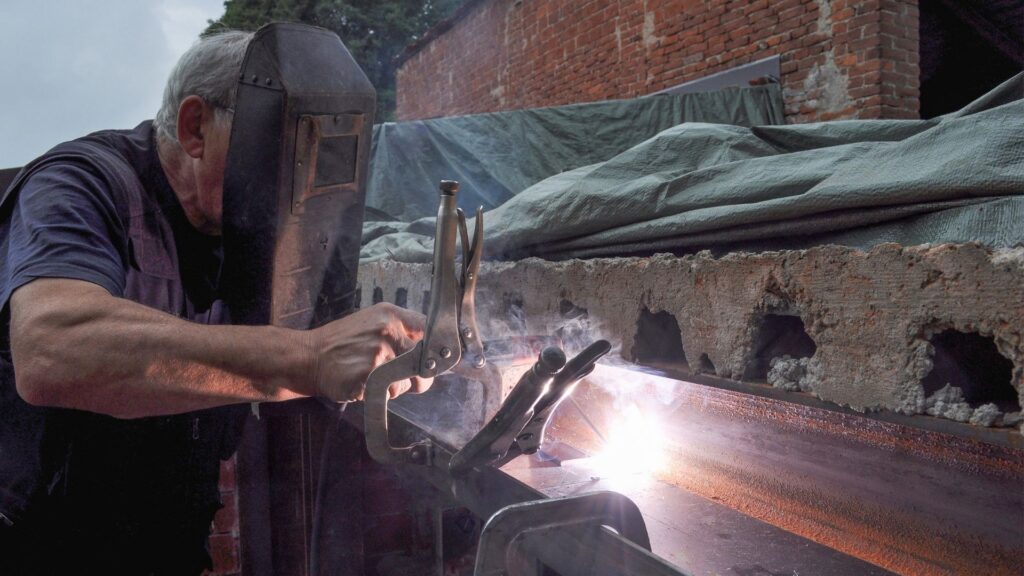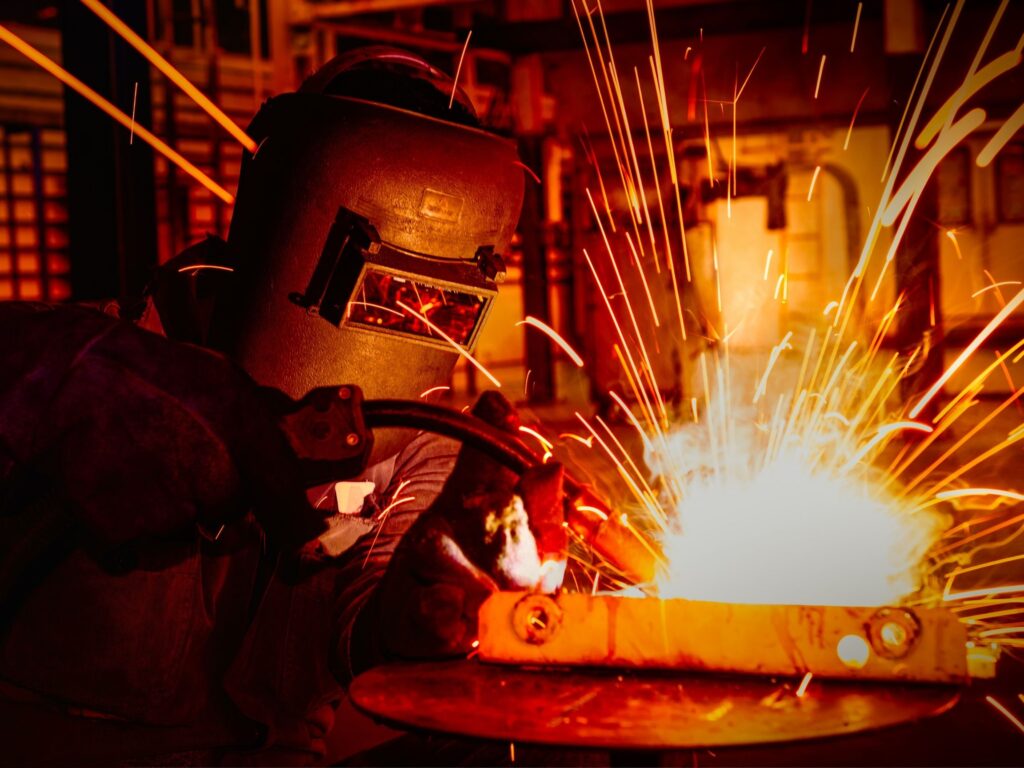My first time welding was in high school. My shop teacher spent a few days going over welding hazards with us before we got started. He detailed all the ways people get hurt welding and even had a slide show of gruesome injuries. I have to say it made an impression.
Welding puts workers at risk for a range of health hazards, the most common is exposure to metal fumes, burns from hot sparks, eye damage, and electrical shocks. You can reduce these risks by wearing personal protective equipment (PPE) and clothing.
Most people agree on the essential safety equipment you need to weld, but it’s also important to check current industry standards and regulations; an excellent source for this is OSHA.

Before going into the safety equipment and PPE’s, I will apply my high school teacher’s formula, discuss the hazards of welding, and then go into safety precautions.
Contents
5 Common welding hazards.
Welding is a hazardous activity that poses many dangers. To minimize the risk of injury or long-term health conditions, you must learn how to safely work with the equipment and be aware of precautions before performing any welding activities.
Failure to follow sound safety precautions can lead to injury or, in the worst-case scenario, death. For these reasons, commercial welders often go through training workshops to learn about proper procedures for working with power sources, gas bottles, and open flames.
Electric shock
Electric arc welding is a process where electricity travels through gas and creates an “arc,” which can be hazardous because it produces heat, light, and other forms of radiation. The most obvious risk associated with this form of welding is electrical shock.
Both primary and secondary electric shocks can cause severe injuries, and if the worst happens, electric shocks can be fatal. You will constantly be exposed to electric shock if you work in wet conditions and highly congested areas where body movement is limited.
There are many ways that someone might get shocked by welding – from improper connections from the welder to failing to wear the proper protective clothing. Always check your machine’s wiring, ensure the clamp is tight and clear of metal outside of your circuit.
Burns
Welding is an intense and dangerous process that uses high-temperature welding arcs, UV rays, and molten metal to create a weld. There is a real risk you will get burned if you’re not wearing appropriate protection during the process.
Sparks from the welding process are hot metal and can burn arms or exposed skin, as well as eyes, and the metal you are working on remains hot enough to burn you even after you stop welding.
Proper PPE is advised, including closed-toe shoes and safety glasses with side shields under a welding helmet. Wearing a helmet, a welding jacket, and covering exposed skin, can help you avoid burns.
Noise
Welding activities such as flame cutting produce a loud noise that can lead to noise-induced hearing loss along with other side effects such as dizziness, ringing in the ears, and increased blood pressure /heart rate.
UV/IR radiation exposure
Strong UV or IR light is produced during welding and can be very detrimental to your eyes. Extended exposure to this beam may lead to cataracts and vision loss.
Gaseous fumes exposure
Exposure to toxic fumes is one of the leading causes of injuries to welders. When gases displace or decrease the percentage of oxygen in your air, it can quickly lead to asphyxiation without warning.
Never work on a welding project in confined spaces with no supply of fresh air; welding produces a lot of invisible and toxic gases that can lead to illnesses such as cancer, pneumonia, asthma, throat and lung irritation.
Be aware of the material you’re working with and take proper precautions, some metal you weld may emit toxic fumes. The type of respirator needed depends entirely upon which elements or chemicals will be vaporized when heated.
With all these hazards, it is clear that you need to follow some safety precautions anytime you do a welding activity. One of the most important safety precautions is wearing the correct Personal Protective Equipment (PPE). Here are the PPE you should buy or be provided with if you work for a company:

Safety Precautions
Welding respirator – Protects the lungs against fumes and gaseous oxides. Always ensure that the respirator is recommended for the welding work you are doing.
Welding helmet and a fire-resistant hood – The welding helmet keeps UV radiation, intense light, sparks, and other burning elements off your eyes and face. A fire-resistant hood protects the back of your head from these elements. You should always follow the manufacturer’s guidelines when using a welding helmet. You need to adjust the filter for the lens until you achieve comfortable visibility that does not irritate your eyes.
Fire-resistant aprons – Shields exposed skin from burns and radiation. The clothing should be made of cotton and not a synthetic material. Also, ensure that the apron has no cuffs and that the pockets are covered.
Fire-resistant Earplugs/muffs- Protects your ears from loud noise. Ears muffs are preferred since they also shield your ears from sparks.
Boots and gloves – Cushions your feet and hand from heat, burns, fires, and electric shock. Go for steel-toe capped shoes with a rubber sole and insulated flame-resistant gloves.
To get the best protection, use PPEs as direct and avoid the following:
Removing your helmet while welding- All welding activities should be done with your helmet on. The welding helmet protects your delicate face and head area from welding elements. Even if you are not practically welding, you should wear the correct PPE when in close vicinity (10 m and below) to the welding workspace.
Keeping the PPEs untidy – You must clean your protective clothing and gears from time to time to ensure that dirt does not compromise some of their properties, such as fire resistance.
Folding up parts of your trouser or sleeves – Cloth folds can trap sparks and potentially cause severe burns. Always keep everything straightened and tucked in, if possible.
Additional safety precautionary measures
Keep the workspace adequately ventilated to ensure that gases and small particulates do not build up.
Eliminate flammables from your welding workspace to reduce the risk of fires
Get trained on how to use welding equipment and the safety precautions that are involved.
Conclusion
Welding is a valuable activity, especially in an industrial setting where metals need to be joined regularly. If done right and following the above preventive measures, you can significantly reduce the occurrence of accidents. On the other hand, serious injuries can occur when you don’t follow safety protocol. Hopefully, this guide helps prevent you from getting injured.
Below is a helpful welding safety training video I encourage you to watch.

Extended Opportunity
Monday 26th of February 2024
Hey,
The moment we've all been waiting for is finally here – GoBuildr is now LIVE! 🎉
🌐 Create ultra-lightning-fast websites, sales funnels, eCommerce stores, and more in less than 60 seconds, with just a keyword!
🚀 Say goodbye to the limitations of traditional page builders. GoBuildr combines the functionality of 16 different tools into one powerful app, supercharged with AI-assisted technology.
⇒ Click Here To Checkout Demo https://ext-opp.com/GoBuildr
Extended Opportunity
Monday 12th of February 2024
Hey Guys,
Warning: From February 2024, all existing email autoresponders will become obsolete!
In fact, if you want to send marketing emails, promotional emails, or any other sort of emails starting in February 2024, you’ll need to comply with Gmail’s and Yahoo’s draconic new directives.
They require regular marketers like you and I to setup complex code on sending domains… and existing autoresponders like Aweber and GetResponse are not helping: they’re requesting you do all the work, and their training is filled with complex instructions and flowcharts…
How would you like to send unlimited emails at the push of a button all with done-for-you DMARC, DKIM, SPF, custom IPs and dedicated SMTP sending servers?
What I mean by all of that tech talk above, is that with ProfitMarc, we give you pre-set, pre-configured, DONE-FOR-YOU email sending addresses you can just load up and mail straight away.
We don’t even have any “setup tutorials” like other autoresponders either, because guess what: we already did all the setup for you!
All of our built-in sending addresses and servers are already pre-warmed with Gmail and Yahoo and they’re loving us: 99% inbox rate is the average!
⇒ Grab your copy here! ⇒ https://ext-opp.com/ProfitMarc
bettie
Tuesday 23rd of May 2023
My room is a little nippy… can you tell http://prephe.ro/Phqn
gertrude
Saturday 20th of May 2023
Lick your way down http://prephe.ro/Phqn
deidre
Tuesday 16th of May 2023
Yeah… I got fucked on that fence right after this http://prephe.ro/Phqn